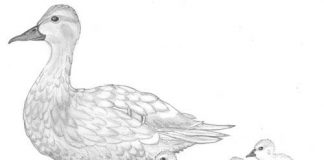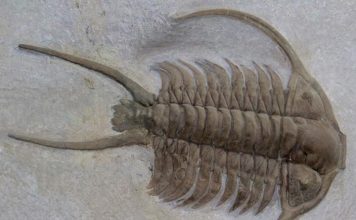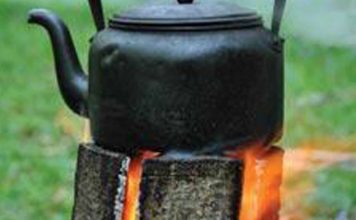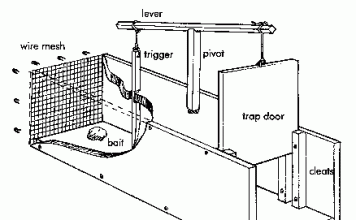|
 |
|
| Issue #77 • September/October, 2002 |
She didn’t say “Hi” or even acknowledge our presence as she jogged past us on the trail that hot August day in Lassen Volcanic National Park in northern California. Even at an elevation of 6,000 feet, it was an unseasonably warm 80 degrees and this young runner, no older than 18 years old, wore skimpy jogging clothes that exposed her skin to the searing sun, while carrying no drinking water. Sweating profusely and with skin bright red, she ran up the trail and out of sight, miles from any trailhead.
A half-mile or so up the trail, we again met up with her. Now sitting on a rock crying, she told us her story. She had been jogging with friends when she became separated. She was lost and had been going up and down trails for hours frantically trying to find her way back. Dehydrated and near heat exhaustion, she was so embarrassed and scared that she didn’t ask for help when she passed us the first time. We gave her water and sat her in the shade as her friends caught up with her and brought her back.
We think of heat illnesses, such as heat exhaustion, heat stroke, or dehydration, as something that affects firefighters wearing heavy protective clothing in hot conditions or something that our soldiers face fighting in the desert. Heat illnesses affect many of us in our daily lives, however. Every year we hear of high school football players that die from heat stroke during summer practice. In athletes, heat stroke is the second leading cause of death. Elderly die in the cities during heat waves. Hikers die, as do those stranded when their cars break down.
In a normal year, an average of 175 Americans die of heat illnesses. During the heat wave of 1980, 1,250 Americans died. The sad thing is that heat illnesses are largely preventable through planning and common sense.
The body and heat
The body produces heat from food and from muscles during exercise. Normal metabolism generates 2,000 to 5,000 kilocalories per day and would raise the temperature of your body 1.5 degrees every hour if it were not for the body’s cooling mechanisms. When you exercise heavily or carry a backpack in hot temperatures, heat production by the body increases five to tenfold. Add to that hot and humid environmental conditions and it is easy to overheat, a process called hyperthermia.
|
Normally, the body reduces heat by sending more blood to the skin where blood vessels dilate to bring the blood closer to the surface where it can be cooled by the lower air temperature. This only works when the air temperature is lower than the body temperature. Normal core body temperature is 98.6 degrees. When air temperatures exceed 95 degrees, the blood is not cooled in this manner.
Sweating is another way the body uses to lower the temperature of the blood. As the sweat evaporates, it cools the body down. Each quart of sweat that is evaporated on the skin removes about 580 kilocalories of body heat. At this rate, body temperature can normally be regulated.
It is necessary to drink 2 to 3 quarts of water per day to maintain normal metabolism. With sweating caused by physical exercise or in hot temperatures, this can easily increase to 4 to 6 quarts per day (1 to 1.5 gallons), or in extreme conditions over 8 quarts per day. It is possible to sweat away 1 to 2 quarts of water per hour in extreme conditions. The U.S. Army warns that soldiers in hot environments can lose 15 quarts (almost 4 gallons) of water per day.
Humidity also leads to overheating. When the humidity level is over 80%, sweat does not evaporate and the body’s ability to cool is dramatically decreased. Sweat produced drips from the skin and only leads to dehydration without providing cooling.
If enough water is not consumed to replace the lost water, blood vessels in the skin constrict since there is not enough volume of blood to keep them open and sweating ceases in order to conserve water for the body. This leads to the body overheating. When heat-control mechanisms of the body are overloaded, the increased body heat rapidly causes tissue damage to the vital organs such as the brain, heart, kidneys, and muscles, and disrupts the chemical processes of the body.
Four environmental conditions determine the risk of heat illness: The absolute air temperature (ambient temperature) is the air temperature as measured with a thermometer in the shade and is the least important cause. Solar load is the amount of direct sun on the skin and can be an important contributor to heat illness. Full sun on bare skin in severe conditions can add up to 150 kilocalories per hour of heat load to an individual. As mentioned, humidity determines the rate that sweat can evaporate and cause cooling. The drier the air, the greater the evaporation and amount of cooling. Humidity is more important than temperature in determining the risk of overheating. Finally, wind speed is an important factor in assisting evaporation. Cool winds reduce heat stress, while hot winds increase it.
Prevention of heat illnesses
Avoid dehydration: The human body is 75% water and needs a constant new supply since we have no method of storing it in our body. Dehydration, drinking less water than the body needs, is the major cause of all heat-related illnesses. Unfortunately, the body is already two to five percent dehydrated before we begin to feel thirsty and losing only one quart more can produce severe dehydration.
The body conserves water by not producing as much urine when it is dehydrated and urine becomes concentrated and dark yellow in color. Urinating plentiful amounts of light-colored urine shows that you are not dehydrated.
Water loss needs to be replaced, requiring a conscious, continual effort to stay properly hydrated to avoid dehydration. Drink fluids even if you are not thirsty. While consuming 2 to 3 quarts of water a day is pretty easy, it gets harder to comply when water needs increase. Plan your daily water consumption, drinking early and often. If you expect to lose 4 to 5 quarts in a day, drink one quart of water when you wake up, one quart with each of three meals, and small amounts frequently throughout the day. The U.S. Army Research Institute of Environmental Medicine estimates that the maximum amount of water that can be absorbed per hour is 1.3 quarts and recommends drinking about two cups every 30 minutes during intense periods of work. For hikers and backpackers, a good rule is to drink every time you take a break or stop briefly. During physical activity, it is easier for your body to handle small amounts of water spread out during the day rather than a large amount all at once.
People avoid drinking enough for many reasons, but it is often because their water bottle is difficult to get out of their pack. Water carrier systems, such as the Platypus or CamelBak hydration systems, are very convenient. They consist of collapsible plastic water containers that are placed in your pack or in a separate water backpack. Using a plastic tube from the water container, you can sip on water as you hike without having to reach for a bottle.
Water needs to be drinkable. Water left in the sun on a 105-degree day will be too hot to drink. Plain, cool water at 60 to 70 degrees is more likely to be consumed, and flavorings, such as Kool Aid, Gatorade, lemonade, and others, may help encourage drinking.
Prolonged sweating from heat or exercise can also cause loss of body salts, called electrolytes. Electrolytes are minerals, such as sodium, potassium, and chloride, in the body fluids. They are essential to maintain fluid balance and function of the nerves and muscles.
Sodium chloride (salt) is lost in large enough amounts during heavy sweating to cause medical problems. When an individual replaces lost fluid with normal water, it further dilutes the concentration of sodium in the body. This salt deficit, called hyponatremia, is essentially water intoxication and symptoms may mimic heat exhaustion or gastroenteritis, making a diagnosis difficult. Recently, it has been recognized that many marathon runners develop hyponatremia during races, and rangers at the Grand Canyon National Park have also seen this problem in hikers.
As with dehydration, the good news is that prevention is fairly easy. Experts recommend eating salty snack foods such as Saltine crackers, Pringles potato chips, Cheez-Its, salted nuts, or drinking sports drinks. Single serving bags of Cheez-Its contain 340 mg of sodium and 20 ounces of Gatorade has 114 mg of sodium, enough to prevent hyponatremia. Salt pills, which irritate the lining of the stomach, are no longer recommended on a routine basis.
Acclimatize: The body takes time to acclimatize to temperature. Firefighters who are brought from the cool coastal areas to inland fires where air temperatures are over 100 degrees suffer a high rate of heat-related illness. It takes several days to as long as a week to acclimatize to hot weather. During this time the body will sweat more and lose more salt, which can lead to electrolyte imbalance. With acclimatization, sweating becomes less and the sweat glands secrete less salt.
|
When first in a hot environment, allow yourself plenty of time to get used to the temperatures before exercising or working for prolonged amounts of time in the heat. To fully acclimatize can take 7 to 10 days, during which time you should exercise about two hours per day. While doing this at home works, most of us don’t have this amount of time to acclimatize when we travel to a new area, such as on vacation. In such cases, minimize the amount of work you do and maximize water intake.
Watch very young and very old individuals carefully in hot weather, as their bodies do not regulate temperature well and they can rapidly become overheated. Age does affect the severity of heat illness. Heat cramps in an 18-year-old may be heat exhaustion in a 40-year-old and heat stroke in someone age 60. Individuals with weight or alcohol problems are especially prone to the heat.
Conserve body water: Minimize or avoid sweat-producing activities in work and travel. This is especially important in survival situations. Stay cool, stay in the shade, and do not lie on hot ground, which can be 30 to 45 degrees hotter than the air. Often, cooler ground can be found by digging just a few inches below the surface. Breathe through your nose to reduce water loss and do not smoke. Eat at a minimum, as water is needed for digestion, and avoid eating fatty foods since they require more water to digest.
Hike or work in the early morning or late afternoon when the sun is low and the heat is less intense, causing less water loss from sweating. Walk at an easy pace and wear lightweight, light-colored, loose-fitting clothes. These allow more ventilation and reflect the heat better than dark colors. Don’t expose your skin to the hot sun and wear a broad-brimmed hat to keep the sun off your face.
Other precautions
Get plenty of rest. The U. S. Army Research Institute of Environmental Medicine has found that fatigue and lack of sleep reduces the body’s ability to regulate heat, causing overheating.
Be aware of the environmental conditions that you may face. Know the anticipated temperature, humidity, wind, and solar load predicted for the day and plan your activity and water intake accordingly. The National Weather Service heat index is a way to help determine the risk of developing heat illnesses. It is a chart that combines the air temperature and relative humidity to derive the “apparent air temperature,” essentially how hot it really feels when humidity is added to the air temperature. For example, an air temperature of 95 degrees with 60 percent humidity has the same effect on your body (apparent air temperature) as 114 degrees. These are for temperatures taken in shady conditions. In full sun, they can be up to 15 degrees higher. At an apparent air temperature above 90 degrees, risk of heat illness is high and activity should be adjusted accordingly.
Certain drugs and medications taken in hot weather conditions can promote heat illness. Avoid taking drugs such as atropine and anti-motion sickness drugs which hinder sweating, beta-blockers which decrease cardiac output, diuretics which promote dehydration, antihistamines and antidepressants which alter normal physiology, and drugs such as hallucinogens and cocaine which increase muscle activity and therefore body heat. Some of these should not be stopped on your own, so talk to your doctor if you anticipate this being a problem.
Management of heat illnesses
Dehydration: Thirst, irritability, nausea, and weakness occur with 5% loss of body water, only 2.5 quarts for a 150-pound person. A 10% loss will cause headache, dizziness, inability to walk, and tingling sensations of the arms and legs. At 15% loss, the tongue becomes swollen, vision can dim, numb sensations occur on the skin, and urination may be painful. Any greater water loss can cause death.
Treatment is to replace lost fluids by drinking water, juice, lemonade, Gatorade or similar sports drinks, soup, or decaffeinated coffee. Drinking alcoholic and caffeinated beverages is discouraged since they increase urination and promote dehydration. Drink until you begin urinating pale yellow urine, remembering that it can take 6 to 8 hours for the fluids in the body to become balanced before urine production will begin.
If the person is not alert or is having prolonged vomiting or diarrhea, they should be evacuated immediately to medical care so that intravenous fluids can be given.
Heat Edema: Heat edema (swelling) is common, especially in the elderly, during the first few days in a hot environment. The hands, ankles, and feet become puffy or swollen and rings may become tight or difficult to remove. Remove rings or constrictive jewelry and minimize walking. When resting, keep the feet elevated. The swelling should resolve on its own within a few days. If leg swelling is associated with shortness of breath or the individual is otherwise ill, swelling may be due to other causes and a physician should be seen.
Miliaria Rubra (Prickly Heat): Prickly heat is an itchy, red, bumpy rash caused by plugged sweat glands on areas of the skin that are kept wet by sweating such as the armpits and groin. Treatment involves cooling and drying the affected skin while trying to avoid further sweating. Itching may be relieved by taking antihistamines, such as Benadryl 25 to 50 mg every 6 hours.
Heat Syncope: Syncope (fainting) is caused by insufficient blood to the brain. In the heat, blood vessels on the skin dilate, taking blood from the brain and heart, and standing for long periods of time causes blood to stay in the legs. Both of these things, along with lower blood volume from dehydration, can cause lack of blood to the brain resulting in a person becoming light-headed, dizzy, or fainting.
Have the person lie down with their legs elevated until the symptoms have resolved. Give them cool fluids to drink while cooling the skin with water or by placing ice packs or cool cloths next to the neck, armpits, and groin.
Heat Cramps: Painful muscle spasms can occur in overheated muscles that are exercised heavily. Often they occur in individuals who are salt deficient. Cramps often begin when the individual is resting after exercise and present as severe pain and spasms of the calf, thigh, abdomen, or hand muscles.
Treatment is to have the individual rest in a cool environment while drinking plenty of fluids. Apply steady, gentle massaging-type pressure to the cramped muscle. Salt drinks or snacks are helpful with heat cramps.
Heat Exhaustion: The most common form of heat-related illness is heat exhaustion. If not treated, it can continue on to become heat stroke, a life-threatening emergency. Heat exhaustion is overheating of the body temperature that does not cause permanent damage, while heat stroke can permanently disable or kill the victim.
Heat exhaustion occurs when the heart and cardiovascular system cannot meet the needs of the skin (temperature regulation), muscles, and internal organs. It usually involves both dehydration and salt depletion. Heat exhaustion is frequently seen as part of other conditions such as illnesses that cause fever, loss of electrolytes, or gastrointestinal illnesses.
|
Symptoms may include thirst, fatigue, nausea, weakness, loss of appetite, vomiting, headache, dizziness on standing from a seated position, and muscle cramps. Sweating is almost always present; however, it may be absent and the skin may feel cool to the touch. Mental status is usually normal, although there may be minor confusion or agitation. The pulse is weak and rapid.
Treatment involves taking the stress off of the cardiovascular system and heart. The individual should stop all physical activity, rest in a cool, shaded environment, and remove any heavy or restrictive clothing. Have them drink plenty of fluids containing small amounts of salt, as you would for dehydration.
While heat exhausted individuals may be able to cool off enough on their own, it is best to use external cooling methods to help them. Cool water can be splashed on the skin while fanning the individual. Better yet, ice or cold packs can be placed along the side of the neck, armpits, and groin areas where large blood vessels are relatively close to the skin. This promotes rapid cooling of the blood. Be careful not to put ice packs directly on the skin for long periods of time. Wrap them in a light towel or cloth.
Individuals with heat exhaustion appear to recover very quickly with the above care. However, it takes the body 24 hours of rest and re-hydration to fully recover.
Heat Stroke: As heat exhaustion progresses, the body’s cooling system completely breaks down and the blood and organs overheat. Known as heat stroke, this is a true medical emergency that has an 80 percent chance of death if not treated.
The difference between heat exhaustion and heat stroke is technically the presence of tissue injury, something that is difficult at best to tell in pre-hospital situation. For practical purposes, anyone who has symptoms of heat exhaustion and abnormal changes in their mental state, such as extreme confusion, disorientation, anxiety, agitation, or inability to walk in a straight line, should be considered to have heat stroke. They may also develop seizures or coma.
Body temperature is hot, usually over 105 degrees. Blood pressure is usually low (check for a weak pulse in the wrist), pulse high (greater than 100 beats per minute), and breathing rapid (over 20 breaths per minute). The skin may be red and hot, although this does not occur with everyone. Sweating may have stopped or may be present.
Heat stroke is a medical emergency that requires rapid hospitalization. Seek help immediately. Above 106 degrees, the body can lose the ability to control its own temperature and temperatures can rise uncontrollably causing severe damage to the kidneys, liver, brain, heart, muscles, and coagulation systems. Intensive medical care is required.
While waiting for help, immediately cool the victim as quickly as possible using the techniques described under heat exhaustion. If available, the individual can be carefully immersed in cool water. Do not immerse in ice water, which can cause severe constriction of the skin blood vessels and limit the ability to lose heat. It can also cause shivering, which is the body’s way to generate more heatnot something you need at this time. Treat for shock by lying the person down with legs elevated.
Do not give the individual anything to drink because of the risk of vomiting and aspirating stomach contents into the lungs. Medicines for fever, such as Tylenol or aspirin, are of no help and should not be given.
Most heat illnesses are entirely preventable through proper planning and hydration. Remember to know the environmental conditions you are facing, stay properly hydrated, and avoid over-exposure to the sun and heat. Doing so will let you enjoy the outdoors without becoming the next victim of the heat.

















